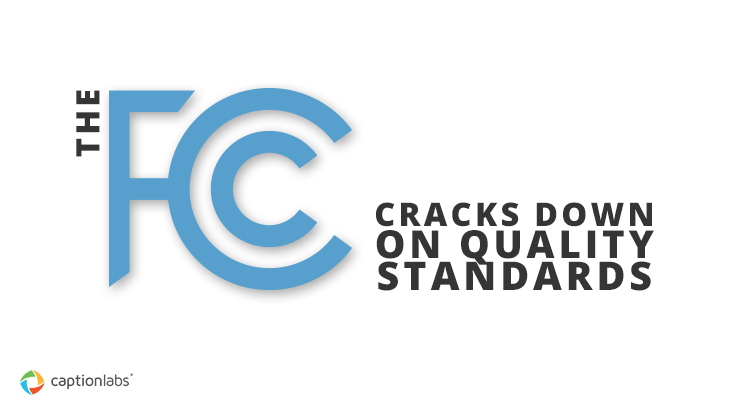Quality is king when it comes to closed captioning.
Think of the last time you visited the doctor’s office or a salon and while you were waiting, a captioned show was quietly playing on the television in the room.
Can you remember all the typos you caught?
Did the words on the screen align incorrectly with the words being spoken?
To the educated, English-speaking, perfect-hearing American, these errors might be funny, at best, and annoying, at worst.
But to the rest of the population—those for whom closed captioning was designed—such errors are a frustrating mess.
So how do these errors happen, how can we avoid them, and who is responsible for fixing them?
THE FOUR FCC STANDARDS
Founded in 1934, the Federal Communications Commission (FCC) exists to regulate interstate and international communications—whether by radio, television, wire, satellite, or cable.
The FCC ensures that all Americans have access to networks without interference, protects the public interest and safety, and strives to make the U.S. a leader in economic and educational development.
The FCC has implemented requirements to ensure and enforce the accuracy of closed captions.
Originally, when captions were mandated, it was just something you did.
Companies would take shortcuts just to get the captions out there and meet the basic requirement.
This malpractice lead to the frustration of many Americans who, in turn, complained to the FCC about the poor quality of the captions they were reading.
So the FCC created the following standards to ensure the quality of closed captions:
1. Accurate
Captions should match not only the spoken words in the dialogue, but should express background noises and other sounds to the fullest extent possible.
2. Synchronous
The timing of when the captions appear needs to coincide with their corresponding spoken words and sounds. They should also be displayed on screen at a speed that is readable by viewers.
3. Complete
As much as possible, captions must run from the beginning to the end of the program.
4. Properly Placed
Placement matters! Captions should not overlap each other, run off the edge of the screen, or block any other important visual content on the screen.
HOW CAPTIONS ARE CREATED MATTERS
When it comes to closed captions, quality is everything. And when you’re choosing a closed captioning partner, it’s important to ask about their process.
Their method will be a major indication of the quality of their captions.
The most accurate and high-quality captions come from people who speak the language natively.
When they learn proper grammar and writing styles, they create closed captions that are both informative and educational.
Generally, if it’s their native tongue, the transcriber will comprehend all the little cultural nuances that come with every language’s phrases.
A classic example of this is the French phrase “Je ne sais quoi.” Using Google Translate, you’ll get an automated, literal, verbatim translation that reads “I don’t know what” in English.
But a French native will tell you that the meaning of the cliché is much deeper. Next time you hear someone say “She has a certain je ne sais quoi,” don’t think “She has a certain I don’t know what.”
Think “She has an intangible quality that makes her unique and attractive.”
While the automation brought by technology often makes our lives (and our jobs) much easier and faster, when applied to closed captioning, automation can seriously decrease quality.
SHORTCUTS & PITFALLS
The FCC designs its standards to avoid complaints and maintain quality control, but some companies still choose shortcuts.
Saving time and money by taking shortcuts sounds like a great idea, but if you cut corners and the quality of your captions suffer, you’ll have to answer to the FCC—and potentially pay for it in the long run.
Here are a few common shortcuts for closed captioning:
1. Voice Recognition
This method uses automation to translate the words and sounds into onscreen text.
iPhone’s Siri is a perfect example of this.
Have you ever asked Siri a question that looked completely wrong on your screen?
Or have you ever received a voicemail on your iPhone and listened to the message while reading the jumbled transcription?
Now try to imagine each of these tools translating an episode of your favorite television show, where there is background music, multiple people speaking, a laugh track, and other competing noises. The results are tragic.
About eight years ago, YouTube launched a closed captions feature, which is genius in theory, but has since received a lot of criticism.
All over the Internet, you can find YouTube caption fails (how do you go from “this place is paradise” to “displaces parents”?).
Although some people joke and laugh about these mix-ups, others feel frustrated and disappointed. The truth is, automation needs much more refinement before it can reliably provide captions.
2. Foreign/Offshore Labor
When a vendor outsources closed captioning to workers outside the native-language country, they call it offshore transcription.
Many companies take this shortcut and hire laborers in other countries who will work for little pay.
Again, this saves money, but when the transcriber doesn’t know the language spoken in the program, they transcribe many words and phrases incorrectly.
3. Crowdsourcing
This is the practice of segmenting one program into multiple small sections and sending each one to a different person to transcribe.
Crowdsourcing often enlists people who have different grammar and punctuation styles and lack the proper and necessary training, resulting in captions that are devoid of cohesion and consistency.
Discount companies use shortcuts like these and claim high accuracy at low costs, which sounds pretty good, right? But the FCC isn’t looking for “pretty good”—it’s mandating perfection.
A company that boasts 99% accuracy mathematically has one error in every 100 words.
But considering the fact that the average person speaks about 200 words per minute, you’re looking at two errors per minute, and that adds up quickly!
Hiring trained professionals who speak the native tongue and are skilled in the subject matter of the program provides the best results.
THE CAPTION LABS DIFFERENCE
This is a No Shortcuts Zone.
At Caption Labs, we don’t sacrifice quality just to save a buck.
Our experts follow a thorough, 21-point process to carefully translate and craft each caption with just the right amount of automation.
Are you looking for a closed captioning partner to do the job right? Contact us and let’s get started.

Ben Kalb
Ben is a broadcast engineer and creator of StationDrop. With a longevity in the broadcast industry, over 20 years, Ben has experience with everything from 1” tape reels to completely file-based workflows. Recently, Ben has broken into the world of coffee. Ask him about his latest brew.


